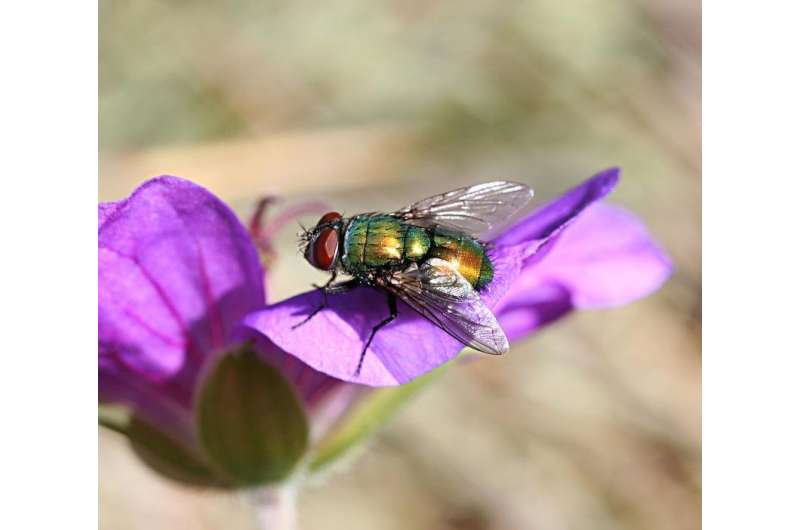April 15, 2015 report
Ecologist finds shimmery insects more difficult for bird to catch

(Phys.org)—Thomas Pike an ecologist affiliated with both the University of Exeter and the University of Lincoln, both in the U.K. has found that one type of bird has more trouble "catching" a computer generated bug that has a shimmering exterior, than with a plain bug. In his paper published in the journal Biology Letters, he describes his experiments and discusses his conclusions.
Many animals and insects have a shimmering exterior where they have coloring that appears to change in color, hue and/or intensity depending on distance and angle. Biological scientists have sought for many years to explain why such coloring, which they call interference coloring, has come about. Some have suggested it has to do with mating, or species identification. Others have gone so far as to suggest that for some it serves as a thermal regulator. In this new effort, Pike suggests that it might be a means of warding off prey.
To learn more, Pike chose to study Japanese quail, because they eat bugs and because they are relatively easy to train. He first trained several volunteer birds to peck at a simulated bug crawling across a computer driven touch screen—doing so successfully resulted in the bird winning a mealworm. Next, he changed the look of the bug on the screen to resemble the coloring of a green bottle fly, which of course has interference coloring and then tested the change in difficulty of the birds trying to peck it. He found that when the bugs were trying to peck the bugs with the special coloring, it took them on average four pecks to get it right, versus two and a half pecks for the plain colored bugs. This he claims, shows that the interference coloring makes it more difficult for the bird to make out its prey. He found that when the birds missed, they tended to miss by a wider margin when pecking at the specially colored bugs as well.
Of course, it is a long way from computer screen to the natural world, as Pike readily acknowledges, but his results have shown enough to indicate that similar experiments will likely be conducted in the wild at some point to see if interference coloring really does make it more difficult to be caught.
More information: Interference coloration as an anti-predator defence, Biology Letters, DOI: 10.1098/rsbl.2015.0159
Abstract
Interference coloration, in which the perceived colour varies predictably with the angle of illumination or observation, is extremely widespread across animal groups. However, despite considerable advances in our understanding of the mechanistic basis of interference coloration in animals, we still have a poor understanding of its function. Here, I show, using avian predators hunting dynamic virtual prey, that the presence of interference coloration can significantly reduce a predator's attack success. Predators required more pecks to successfully catch interference-coloured prey compared with otherwise identical prey items that lacked interference coloration, and attacks against prey with interference colours were less accurate, suggesting that changes in colour or brightness caused by prey movement hindered a predator's ability to pinpoint their exact location. The pronounced anti-predator benefits of interference coloration may explain why it has evolved independently so many times.
Journal information: Biology Letters
© 2015 Phys.org





















